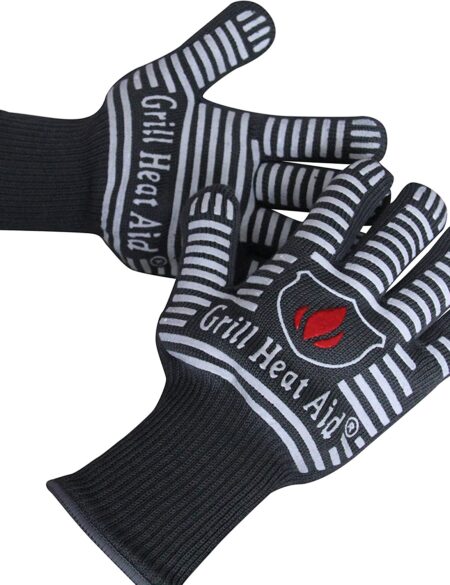This content was originally published on OldHouseOnline.com and has been republished here as part of a merger between our two businesses. All copy is presented here as it originally appeared there.
Hand planers are simple tools with a straightforward job but choosing the best one for your project is not always easy. Whether you’re looking to smooth a surface or adjust the size of a board, this is definitely a tool that can make time spent in your shop more enjoyable. So today, we’re taking a look at the best hand planers, from the best budget version to the best overall buy. To top it all off, we’re also exploring all the things you should take into consideration before deciding on the tool that you should purchase. Let’s dive in.
Comparing the Best Hand Planers
Amazon Basics Hand Planer
– Best Overall
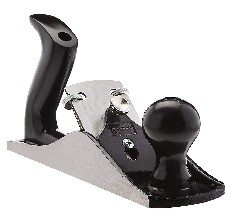
This sturdy tool is a great low-tech hand planer that will get the job done with precision and stability. Its blade is made from steel alloy, and it’s designed for quality cutting. Like all manual tools, it needs some fine-tuning before getting down to business. It’ll work best with a bit of sharpening and adjusting, but it’s a great budget buy.
Key Features
The blade adjustment works as intended, but getting used to the mechanism involves a learning curve. Our advice is to spend some time testing the tool on a practice piece of wood. Some might find this mildly inconvenient, but in our view, it’s worth it for the price point. The sole and plane iron will need some flattening but this should not come as a surprise. Even more expensive competitors will need this sort of attention.
Pros
- Made from quality material
- Has a heavy cast iron body that gives it stability
- Comes with a 1 year limited Amazon warranty
- It’s a great, affordable option
Cons
- You will need to sharpen the blade before use
Bosch Hand Planer
– Runner Up
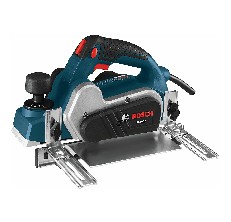
A great power tool that carries the quality of the Bosch brand, this planer will satisfy beginners and experienced woodworkers alike. If you’re a beginner, make sure to watch some tutorials and get familiarized with the operation of this tool. It packs quite a punch at 16,500 rotations per minute. The cut adjustment is precise to a T, and it will be a pleasure to work with because of this accuracy.
Key Features
The solid feel of this planer is reassuring, and the quick setup time will make your entire woodworking process more efficient and more comfortable. As with all tools, you’ll likely need to get a feel for its weight and cut before taking it for a spin on a real project, so we always recommend sacrificing some scraps of wood for this purpose.
Pros
- 6.5 Amp rating and 16,500 RPM speed that can handle any type of wood
- The convenient shape allows for starting to plane in the middle of the workpiece
- Comfortable handle that makes gripping and angling the tool a breeze
- Has an inch and metric depth scale
Cons
- Can get pricey if purchased along with the kit
PORTER-CABLE Hand Planer
– Honorable Mention
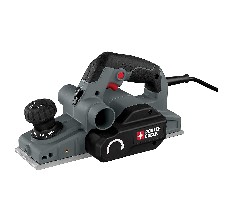
A great tool for a great price – this is a surprise find. It will hold its own against much more expensive competitors, and from the blades to the front shoe it will work longer and cheaper than others too.
Key Features
This tool is light to use and will cause minimal fatigue without sacrificing any raw power. Don’t expect any frills; this is a straight-up, no-nonsense tool that does one job, and it does it well. It’s especially well suited for beginners because of its accessible price point, which will allow them to do easy work with a great quality planer without needing to break the bank. However, if you’re only using it once in a while, it’s best to practice before each use to make sure you’ve reacquainted yourself with its operation.
This tool will perform at the same level as pricier competitors for a fraction of the price. Truly a bargain.
Pros
- Powerful 6 amp motor and 16,500 RPM
- Dust extraction on both sides of the tool
- The cut depth knob includes 10 steps for increased control
- Accessible price
Cons
- Requires care when operating to avoid accidentally changing the depth while cutting
WEN Hand Planer
– Also Consider
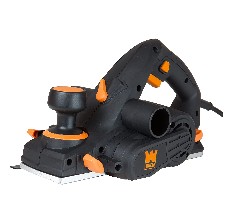
A great budget option that can make your life much easier if you’ve been using a manual planer until now. This tool does not require a significant investment, but it has the power and all the fixings of a high-caliber electric planer. This is THE planer for hobby projects. Although it’s not well-suited for professional woodworkers, any hobbyist or DIYer would be glad to have it. Keep in mind, though, that it can get overheated with heavy use and will require a lot of maintenance if you use it on a day-to-day basis.
Key Features
However, if you’re just taking up woodworking as a hobby or doing the occasional project for a neighbor or friend, this might be just what you’re looking for. Packing enough of a punch to smooth out your material in no time will make all woodworking a delight.
Pros
- 6-pound light design for minimum strain
- Includes a kickstand and parallel fence bracket
- Comes with a 2-year warranty
- Great performance for the price
Cons
- Can get overheated with excessive use
Buying Guide for the Best Hand Planers
The type of hand planer you will need will depend on the type of job you need. For our purposes, we will cover the two main types of hand planers: the manual hand planer and the electric hand planer.
Manual or Human-powered Hand Planers
Manual planers are traditional tools powered by you through back-and-forth motions on the wood. The hand planer is ideal for putting the finishing touches on your work or smoothing out the last fine shavings. This tool can be adjusted to take off thicker or thinner shavings but it does require patience and some finesse.
Hand planers are made from either metal or wood, and choosing the right material is important for the quality of your work.
Metal ones are more durable, and you can leverage the extra weight against the wood, especially when working horizontally as you are leaning the tool on the surface. Metal hand planers are also easily adjustable through a mechanism on top of the tool, giving you good control over your shavings.
Wood hand planers are a bit of a rarity among hobbyists these days. They’re mostly nostalgic purchases or are found in the workshops of experienced woodworkers who like the vintage feel. However, these tools are lighter than their metal counterparts, so they’re less fatiguing to use when shaving a vertical piece of wood. The main disadvantage of this option is that adjusting means using a mallet and it’s a time-consuming business.
Another consideration to keep in mind is that most of these planers will come with blades that need to be sharpened before being put to good use. In our experience, only the most expensive tools come perfectly sharpened out of the box, so if you’re not willing to pay for the brand, you’ll have to give the tool an extra 20-30 minutes before putting it to work.
Among the manual hand planers, there are a few subtypes to look at.
Blank planers
The most convenient both in terms of design and price, blank planers are small but handy. They’re comfortable to hold, and they’re used specifically for planning end grains.
Leveling planers
These are heavy planers with long and wide bodies primarily used to flatten larger surfaces or straighten edges.
Smoothing planers
A short planer, made for creating a very smooth surface, this tool can make thin cuts into your material. It’s perfect for prepping your piece for finishing or for doing your own final refinements on your work.
Jack planers
This is the most versatile type of manual planer out there. It is longer than a smoothing planer, shorter than a leveling planer but it can acceptably accomplish the jobs of both. It will do a good enough job if you’re not looking for too much precision or perfection in either task.
Electric Hand Planers
More suited for harder, less minute work, this is truly a powerful tool and it has the potential to make your time woodworking more pleasant and efficient. It’s ideal for larger, heavier, or longer wood, there are really no limits with this tool. As long as you can reach it, you can shave it. This is not going to be a good tool for putting the last subtle touches on your work, but it is great to shave a stud down.
Electric hand planers have less variety than human-operated ones, and they definitely have a less traditional feel, but they’re a joy to use. Keep in mind, though, that these, like most power tools, can be dangerous to use, so take all appropriate safety precautions and make sure you are well-informed before putting your hands on one.
When assessing which electric hand planer is best for you, you should be aware of the following aspects.
Blade design
The most efficiently designed electric planers have multiple blades spinning to cut the material. This is preferred to single-blade alternatives, which will also dull faster.
Power
Make sure to go for a planer that can pack some serious punch. A minimum of 5 Amperes is needed, although 6 Amp will be the sweet spot.
Weight
This is a tricky situation and one that will be determined by the kind of use you anticipate for your power tool. In the case of hand planers, heavier likely means more quality and durability, but it also means more fatigue. And since it’s a hand-held power tool, being able to keep a good, firm grip is essential. Consider what type of projects you’ll be doing and how long you’ll be spending on them before making this decision.
People Also Asked
Q: When do you use a hand planer?
A: Hand planers are used to smooth out pieces of wood by removing thin shavings from the surface. They’re ideal for shaving edges of sticking doors, smoothing out the rough end grain of a piece of wood, or tapering wood.
Q: Can you use a planer to take off paint?
A: You can, but there is a caveat. Painted wood will dull the edges of your blades pretty fast, and while this doesn’t completely ruin them, it can be an inconvenience. However, if you’re particularly keen on using a specific piece of wood and think it’s worth the resharpening effort, the planer will do its job.
Q: How much can a planer take off?
A: Planers are adjustable, and the depth of the cut can be altered to suit your preference; however, the maximum an electric planer will be able to take off is about ⅛ of an inch in one pass.
Q: Which is better: a jointer or a planer?
A: Jointers are used to create boards that have perfectly flat edges so that they can be subsequently joined in order to create a wider board. The planer can then take the piece of wood and make the second face flat and parallel to the first. Which one is better depends on your purpose, but a planer is probably the better tool to start with if you’re only looking to purchase one at this time.
Q: Is an electric hand planer worth it?
A: Electric hand planers can make your life much easier, especially if you have a lot of project planning doors. This tool makes smoothing out wood an easy job, and there are plenty of budget options to consider if you want to make this aspect of woodworking easier without splurging.


